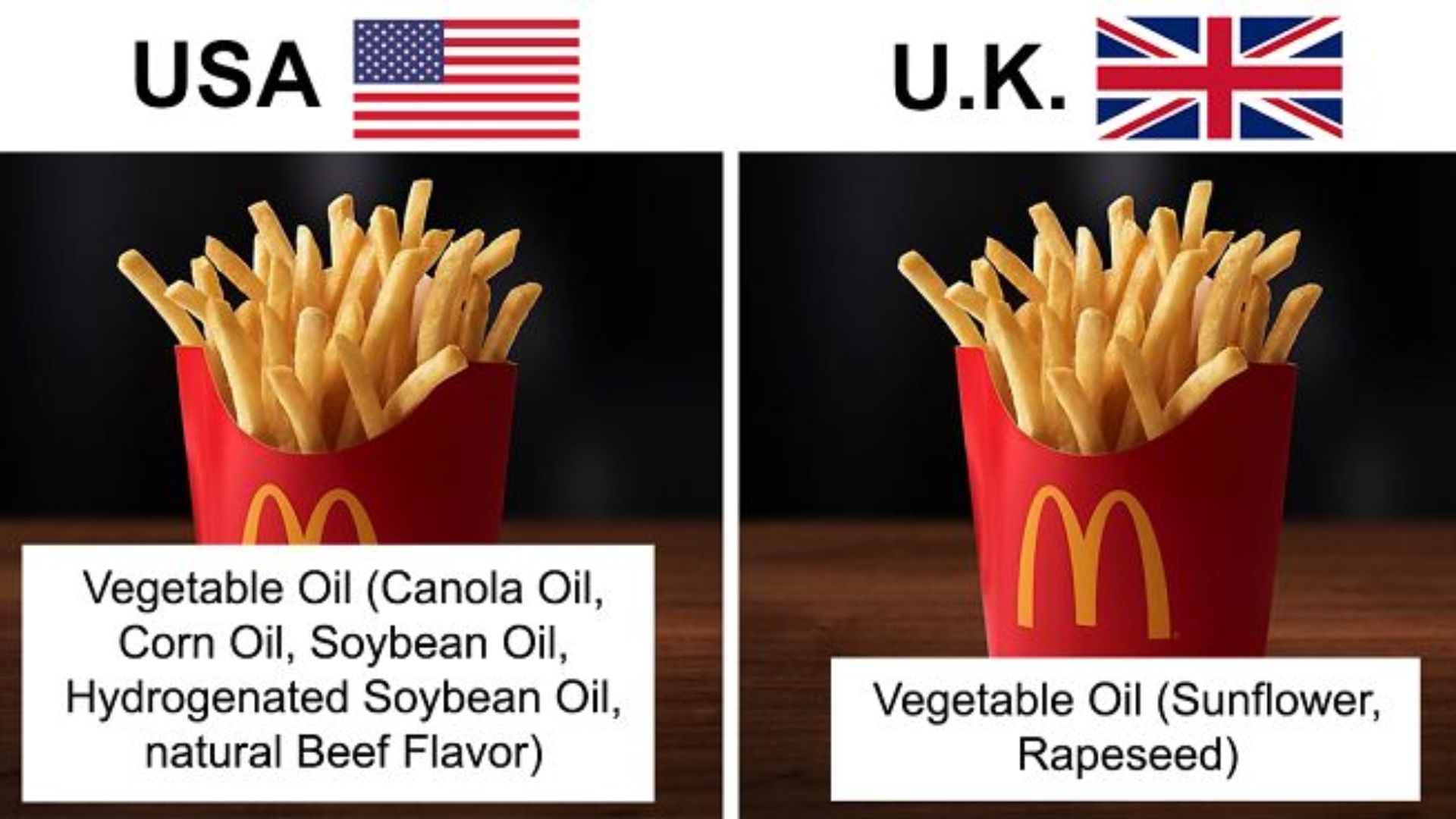Food is the universal language that transcends borders, bridges cultures, and tickles the taste buds of millions. Today, we embark on a journey through the captivating world of European and American food culture, peeling back the layers of culinary diversity that make these continents stand out. Buckle up and prepare to navigate through the intriguing nuances, oddities, and delightful quirks of each region’s gastronomic identity.
The Fork & Knife Tango
Culinary traditions extend far beyond the ingredients and flavors; they include the tools we use to eat. The way Europeans and Americans handle their cutlery is a delightful testament to their distinct dining styles. European dining styles are the epitome of grace, where the fork stays firmly in the left hand. Meanwhile, Americans perform a dance with their fork and knife, swapping hands with each bite. Let’s have some fun unraveling the history behind these cutlery quirks.
In European dining, the fork remains in the left hand while cutting with the knife in the right. This approach eliminates the need to switch hands and facilitates a smoother dining experience. European diners often angle the fork downward and curve it upward when bringing food to the mouth. They use the knife more frequently to transfer food onto the fork. The signal for finishing a meal involves placing the cutlery down, an elegant and subtle gesture.
In contrast, American dining, often referred to as the “zigzag” style, involves holding the fork in the left hand and the knife in the right, shifting the fork to the right hand after cutting each bite. This style prohibits placing food in the mouth while holding the knife and involves minimal use of the knife to load the fork. Signaling the end of the meal involves placing the fork and knife parallel from the top left corner to the bottom right corner of the plate. It’s an efficient style, but it can sometimes come across as a bit rushed.
The roots of these dining distinctions trace back to historical events, notably World War II, where different dining styles could have significant consequences. Today, flatware is designed to suit the nuances of each dining style, with European-style knives being lighter and more comfortable to hold compared to their American counterparts. It’s worth noting that even in the United States, fine dining and business dinners often embrace European dining styles, highlighting the adaptability of these practices.
The fork and knife tango offers a delightful window into the divergent approaches to dining on both sides of the Atlantic. It’s not about which is better; it’s about celebrating the diversity and embracing the quirks that make food culture so fascinating.
Savoring the Communal Feast
In the world of food, Europeans have a knack for transforming the act of eating into a communal experience, rich with tradition and significance. While Americans often munch on the go, Europeans see food as an art of connection. It’s not just about sustenance; it’s about sharing and savoring life’s simple pleasures. Let’s explore how Europeans invest hours in sharing hearty meals with friends and family, focusing on conveying affection through food.
Martial and Anne-Cecile, a European couple with five children, recently returned from their homeland in the French part of Switzerland. They introduced their children to various European culinary experiences, and their summer sojourn included attending school in Switzerland. Here, they encountered a lunch culture distinctly different from what’s typical in the United States.
While there were subtle nuances differentiating European diets and eating habits from American ones, the fundamental divergence lies in how we perceive food. Martial eloquently captured this disparity as they savored their first course, emphasizing that in Europe, food is all about the communal aspect of the table and the act of sharing. In contrast, in America, food can sometimes be reduced to a mere vehicle for nutrition.
This reflection struck a chord, and it brought back memories of hurriedly consuming fast food during lunch breaks and sneaking away from communal gatherings to savor a cheese plate in solitude. Martial’s point was undeniably valid; in parts of Europe, food takes on a deeper meaning as it becomes a vessel for nurturing relationships.
He further explained that when people invest hours in sharing a large meal with friends and family, the focus is on conveying affection through food, and the notion of guilt over indulging dissipates. This contrast led me to ponder how different our lives would be if we abandoned scarfing down meals in vehicles and instead embraced a slower pace, pausing to sit down and savor dinner without distractions, like the occasional Jeopardy-watching habits my husband and I had developed.
These insightful revelations continue whilst delving further into the distinctions of European food culture.
To Snack or Not to Snack
Europeans tend to avoid snacking, a practice that keeps their meals substantial and nourishing, thanks to real ingredients. Their meals comprise hearty breakfasts, multi-course lunches, and modest dinners, rendering snacking unnecessary.
Lunch takes center stage as the largest meal of the day, surpassing dinner in importance. Children often return home from school for a two-hour lunch break to enjoy a substantial meal. Even working professionals sometimes partake in this tradition, while school lunches for children remaining at school feature gourmet offerings with multiple courses.
Europeans predominantly consume water and wine, eschewing sugary drinks in oversized containers. This approach helps reduce overall sugar consumption and promotes healthier hydration habits.
Unlike the American culture of eating on the go, European meals are cherished as intentional moments to sit and savor food. You won’t often find people in Europe strolling around with large tumblers or Corkcicles, casually consuming drinks or snacks while on the move.
Respect the Food
European children are raised with a profound respect for food. Unlike the United States, where marketing often targets specific foods for children, European children grow up consuming what their parents eat. Even in French-Swiss restaurants, children’s menus feature smaller portions of adult menu items with minimal alterations. Children actively participate in the cooking process, fostering an appreciation for food, cheese, and even wine, mirroring their parents’ respect for these culinary delights.
In juxtaposition to European dining customs, the dining practices in the United States stand out. Americans are known to eat faster and prioritize convenience, often sacrificing the pleasure of leisurely meals. American dining styles, characterized by using flatware in distinct ways, diverge notably from European customs:
Right vs. Left: Stop Forking Around
In American dining, diners hold the fork in the left hand and the knife in the right, shifting the fork to the right hand after cutting each bite. This style prohibits placing food in the mouth while holding the knife and involves minimal use of the knife to load the fork. Signaling the end of the meal involves placing the fork and knife parallel from the top left corner to the bottom right corner of the plate.
But let’s not forget, that culinary customs are not set in stone, and they evolve with time. Food culture is a living, breathing entity that constantly adapts to the needs and preferences of a society. Fine dining establishments and business dinners in the United States often embrace European dining styles, showcasing the adaptability of these practices. Whether it’s the “fast food nation” image or the leisurely multi-course European feast, food customs are ever-evolving.
Hydration Showdown
In one corner, you have Europeans predominantly sipping water and wine, reducing overall sugar consumption. In the other corner, Americans wield oversized sugary drinks. Let’s raise our glasses and explore the battle of the beverages, where Europeans win the day for healthier hydration habits.
Europeans have a strong penchant for savoring pure and natural flavors. Water, often served at room temperature, is their beverage of choice to accompany meals. Wine, with its deep roots in European culture, is celebrated not just for its taste but for the way it complements food.
On the American front, it’s no secret that they have a soft spot for sugary drinks. Large cups filled with fizzy sodas, fruit juices, and extravagant milkshakes are the norm. These super-sized, sugar-laden beverages are the epitome of the American way of life, providing a quick and accessible source of sweetness.
The impact of these choices on health is significant. By predominantly consuming water and eschewing sugary drinks in oversized containers, Europeans inherently reduce their overall sugar intake. This conscious choice promotes healthier hydration habits and contributes to better well-being.
The contrast in beverage choices is a stark reminder of the importance of dietary habits and how they can vary widely across cultures. While sugary drinks are a ubiquitous part of the American food landscape, Europeans demonstrate the beauty of simple hydration through water and the art of wine pairing.
Buttergate: The Great Sandwich Showdown
Ah, the age-old battle of butter versus mayo and mustard, a gastronomic clash that rocked the foundations of food culture. It all started with a simple sandwich, or rather, a baguette. Europeans, notably the French, have an enduring love affair with butter. They slather it on their bread, generously, without hesitation. Meanwhile, across the Atlantic, Americans have been known to reach for condiments like mayonnaise and mustard. You’d think it’s a mundane matter, but “Buttergate” proved that when it comes to food, nothing is trivial.
The “Buttergate” saga began when Amanda Rollins, a lively American expat who had spent more than six years in Paris, took to TikTok to share her culinary revelations. In her viral video titled “Buttergate,” Rollins showcased the French way of making sandwiches – using a baguette and spreading French butter on both sides. The classic French sandwich, typically filled with ham, cheese, and butter, eschews mayonnaise or mustard. Rollins passionately defended this practice, describing it as unexpectedly delicious.
The video resonated with viewers worldwide, but the reactions from Europeans were particularly strong. Many couldn’t believe that Americans didn’t embrace butter in their sandwiches. On TikTok and other social media platforms, they expressed their disbelief, and soon, the “Buttergate” controversy became a full-blown online sensation.
In response to the overwhelming attention, Rollins released a follow-up video, “Buttergate 2.0,” to clarify her perspective and address the ongoing discussion surrounding this culinary divide. It’s amazing how such a seemingly simple topic can spark passionate debates and fervent discussions.
Breaking Bread
While exploring the delightful clash of European and American food cultures, one thing is clear – both sides have their quirks and charms. “Buttergate” and the fork & knife tango might spark laughter and debates, but they also remind us of the richness of global food customs. In the end, it’s essential to appreciate and learn from various food traditions, because, after all, food is a universal language that brings us all to the table. Cheers to culinary diversity, and to the delightful, ever-evolving tapestry of our global food culture!


































